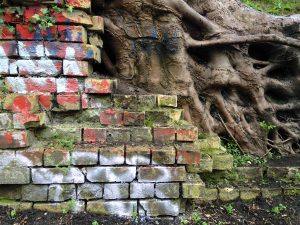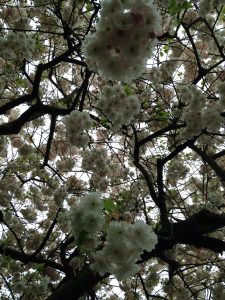Home » News » Blog » Graffiti: meditations on the source of our creative urges
Graffiti: meditations on the source of our creative urges
Graffiti: meditations on the source of our creative urges
Kerry-Lee Powell, writer

Spring can be a damp, drawn-out affair in Britain, but anyone who agrees with Eliot that April is the cruelest month has never spent March in New Brunswick, where winter often seems less a season than a full-blown existential crisis. I flew to London on writing business but the air was balmy and the trees in blossom, and I found myself ducking out on lunch dates and planned excursions to libraries and museums so that, dizzy with jetlag and general rapture, I could stumble around open-mouthed in the city’s green and flowering spaces.

There were plenty of these within ambling distance from the posh flat in Highgate where I stayed as the guest of generous friends. It’s an area beloved by rich Americans, I suspect because it offers glimpses of a bygone age, its leafy vistas largely uncluttered by futuristic architecture or industrial chic. What it lacks in culture clash it makes up for in manicured heathlands and daffodil-strewn copses and a famous gothic graveyard that has been the setting of a dozen horror movies. Having spent a chunk of my early adult life reading Victorian novels, I’m not immune to the pleasures of living with one foot in the past. Strolling down Highgate’s woodsy pathways, it was difficult to imagine not bumping into a gent in a stovepipe hat or a heroine in a bustled gown.

So it came as a minor jolt to see, through young leaves, the first angular streaks of neon pink and fluorescent yellow at the mouth of an old tunnel. The interior brickwork was inscribed with names and scuffed shapes difficult to make out in the murk. The sun came out from behind a cloud just as I stepped out into daylight, bathing the path ahead in an almost unnatural radiance. I had the sensation that I was less a tourist now than a visitant to an imaginary world. Nearly every surface within view was painted or scrawled upon in bright colors. I paused by a few illegible words on a tumbledown wall and snapped a photo. Next to the gnarly old tree roots, the spray-painted words seemed a little uncanny, as though they might be the work of ogres or forest trolls. A few steps on, I came upon a large mural of a phoenix-like bird. The brushstrokes were vibrant and made, like many of the murals on the pathway, with ordinary house paint. Some, like my bird, had a ragged intensity, were like windows into the mind’s raw interior. I’m not a stranger to the social impact of graffiti, but set here against a backdrop of trees and decaying brickwork, the images felt more like a protest against oblivion than a political gesture.
 When I went back a few days later most of the paintings I’d seen were gone, many of them painted over in a black and white series that included a single, psychedelic eye set in the socket of an alcove. All that was left of my phoenix was a piece of wing, its body painted over with crude geometric shapes. So much of what I know about art is about permanence or its illusion, from the canonical works I studied in university, to the paintings and Grecian marbles in the museums I was playing hooky on. What doesn’t strive for immortality seems fashioned for commercial ends. But here was powerful work beyond those domains, a gallery seemingly dedicated to the act of creation itself, each work transient as a hallucination, exposed to the vagaries of any passerby with a paintbrush in her hand.
When I went back a few days later most of the paintings I’d seen were gone, many of them painted over in a black and white series that included a single, psychedelic eye set in the socket of an alcove. All that was left of my phoenix was a piece of wing, its body painted over with crude geometric shapes. So much of what I know about art is about permanence or its illusion, from the canonical works I studied in university, to the paintings and Grecian marbles in the museums I was playing hooky on. What doesn’t strive for immortality seems fashioned for commercial ends. But here was powerful work beyond those domains, a gallery seemingly dedicated to the act of creation itself, each work transient as a hallucination, exposed to the vagaries of any passerby with a paintbrush in her hand.
[Tweet “If the pieces can be seen as an emblem of ephemerality, they are also one of imaginative vigor.”]  As a writer, it’s difficult to get away from history. We learn our craft, and reading widely and deeply is both inspiring and illuminating. It can be difficult to be alive to the present in the face of that monumental and ongoing task. There’s a certain amount of undoing or forgetting that needs to take place in order to honor the raw green impulse to create, the source of which is both mysterious and fertile. It’s an impulse that can often be mistaken for emotion but never for sentimentalism. Imaginative work that I really love, no matter what the medium, shares the same urgency and dynamism as the rough paintings I saw in the woods, a vividness to which the niceties of style and contextualization should always be in service. I’m trying to keep that spark in mind as I pore over drafts of the novel I’m in the middle of writing. It’s a wintry March again, and it’s been almost a year since my trip to London. One look at these photographs though, and the past springs back to life.
As a writer, it’s difficult to get away from history. We learn our craft, and reading widely and deeply is both inspiring and illuminating. It can be difficult to be alive to the present in the face of that monumental and ongoing task. There’s a certain amount of undoing or forgetting that needs to take place in order to honor the raw green impulse to create, the source of which is both mysterious and fertile. It’s an impulse that can often be mistaken for emotion but never for sentimentalism. Imaginative work that I really love, no matter what the medium, shares the same urgency and dynamism as the rough paintings I saw in the woods, a vividness to which the niceties of style and contextualization should always be in service. I’m trying to keep that spark in mind as I pore over drafts of the novel I’m in the middle of writing. It’s a wintry March again, and it’s been almost a year since my trip to London. One look at these photographs though, and the past springs back to life.
Powell is reading at UNB on Monday March 30th






